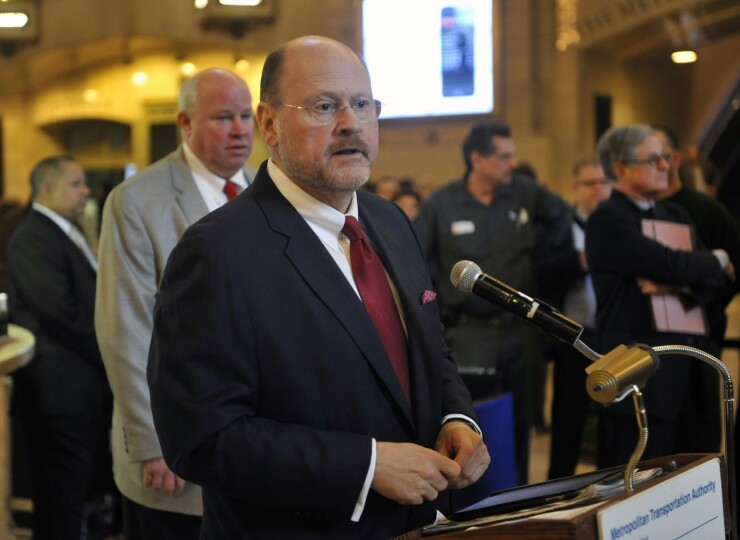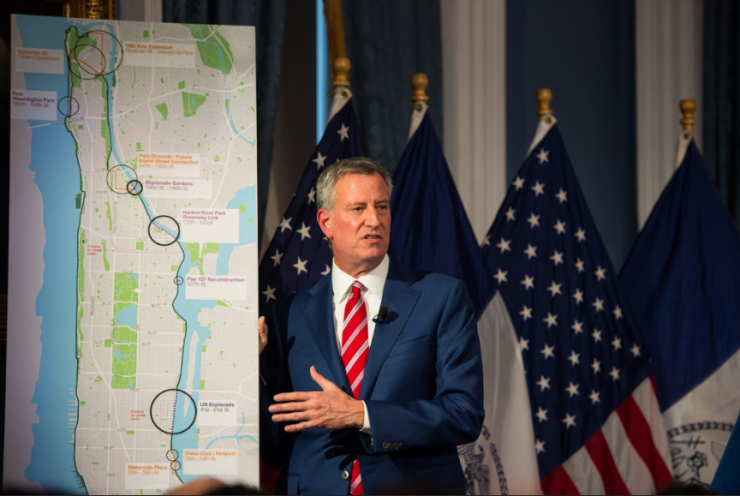The New York Metropolitan Transportation Authority may have to raise fares and tolls faster than planned if new sources of funding are not found soon, according to an
"Maintaining, modernizing and expanding the largest mass transit agency in the nation is critically important to the future of the New York metropolitan region," DiNapoli said. "In the absence of adequate funding, the system could fall into further disrepair and riders could face unplanned fare hikes.”

Although the MTA has invested more than $120 billion in capital improvements since its first capital program began in 1982, the pace of investment has not kept up with the need, the report said.
The analysis showed that some of the largest funding needs remain in the subway system, where signals, power, stations, repair shops, pumps and emergency ventilation equipment have not been restored to a state of good repair, and subway car purchases have been delayed.
The average distance subway trains travel before breaking down fell around 33% to 112,000 miles in 2016, the shortest distance since 2001 while on-time performance dropped sharply, the report said. Almost one-third of the subway fleet is over 30 years old and about 40% of the signals in the system are over 50 years old. The sharp growth in subway ridership over the past 15 years has also been straining the system, which operates 24 hours a day, seven days a week.
“The state and city need to find solutions to prevent these possibilities from becoming reality and the MTA must make the best use of its resources," DiNapoli said.

“The MTA needs a steady income stream to continue to maintain a state-of-good repair while at the same time upgrade and expand the system,” said MTA Chairman Joseph Lhota. “We are extremely encouraged by the growing support for congestion pricing and we categorically reject the idea of any unplanned fare increases. Funding subway repairs will not come on the backs of riders and the comptroller is fear-mongering by injecting unplanned fare increases into the public discourse.”
The Tri-State Transportation Campaign, a non-profit group that wants to reduce car dependency, also pushed for a congestion pricing model, which would raise revenue through tolls on drivers at peak travel times.
“Comptroller DiNapoli’s report shows exactly why riders need congestion pricing now,” said Nick Sifuentes, executive director of Tri-State. “The consequences of underinvestment in the MTA are clear: Delays and breakdowns are up, and ridership is down as New Yorkers look for more reliable ways of getting where they need to be.”
Jamison Dague, director of infrastructure studies at the Citizens Budget Commission, lauded the report.
“The comptroller's financial outlook for the MTA highlights many of the
New York State Gov. Andrew Cuomo and New York City Mayor Bill de Blasio support new revenue sources for the MTA, but they disagree on the way to do it.

“The MTA has a tremendous amount of work to do to get our system back up to par. But so do our elected officials, who have to find sustainable funding sources for our subways, buses, and commuter rail,” Sifuentes said. “Fortunately, both the governor and mayor are proposing solutions that don’t burden riders, who are already paying their fair share. Whether congestion pricing or a millionaires’ tax, our representatives have to find a progressive solution to the crisis on our public transit system.”
DiNapoli’s report notes that the MTA is projecting a balanced operating budget through 2019, but it is also projecting budget gaps in the following years, starting at $112 million in 2020 and growing to $493 million in 2021, despite planned biennial fare and toll increases of 4% in 2019 and 2021. The MTA has already raised fares and tolls by 4% in 2017.
The MTA’s estimates assume uninterrupted economic growth, $1.4 billion in unidentified cost savings and the restoration by the state of $65 million in annual funding to offset the revenue loss to the MTA from a reduction in the payroll mobility tax on small businesses, the report said.
The MTA, which is a state-run agency, announced a two-phase Subway Action Plan in July to address the system's deterioration.
Phase 1 is estimated to cost of $836 million and will focus on stabilizing and improving the subway system. The MTA has urged the state and the city to split the cost, but no agreement has been reached yet so the MTA has been drawing on its reserves to begin Phase 1. The MTA had projected that Phase 1 would be completed in 2019, but it now hopes to complete Phase 1 by the end of 2018. The MTA still has not explained how the cost of increased subway maintenance will be funded after state and city funds are exhausted. After the completion of Phase 1, recurring costs could exceed $300 million annually, the equivalent of an unscheduled fare and toll increase of about 4%.
Phase 2, with an estimated cost of $8 billion, will focus on modernizing the system and will be included in the 2020-2024 capital program. The MTA has not yet indicated how these costs would be funded, the report said. The MTA is contributing 43% of the funds for the 2015-2019 capital program.
The comptroller’s analysis says the “cumulative impact of the 2015-2019 program and prior capital programs has placed a heavy burden on the operating budget and on those who use the transit system in the form of higher fares and tolls. Debt service and other operating resources that support the capital program are projected to increase by 22% over the next five years to $3.5 billion, consuming one-fifth of all MTA revenues.”
Debt outstanding is forecast to hit $42.6 billion by 2022, $7 billion more than five years earlier, the report said, and that does not take into consideration the capital program.

The report also noted the uncertainty surrounding policy decisions being made at the Federal level.
“The MTA is counting on the Federal government to fund almost one-quarter of its capital program, but there is uncertainty regarding these funds,” the report said. “For example, [President Trump] has proposed eliminating the New Starts program, which the MTA assumes will fund one-third ($2 billion) of the estimated cost of Phase 2 of the Second Avenue Subway.”
Although the state has committed to contributing $8.5 billion to the 2015-2019 capital program, it has not yet identified the source of $7.3 billion of its commitment. The state commitment could be met through MTA bonds backed by an existing or new state revenue source. The Governor recently announced the state's intention to contribute an additional $1 billion to the current capital program, but the source of that funding has also not been identified.
The 2015-2019 capital program had a funding gap of $15 billion when it was first proposed. It took 17 months before the state, the city and the MTA could agree on a funding formula to close the gap, which delayed a number of projects. The 2020-2024 capital program could have an even larger gap in the absence of solid commitments from the state and the city, or a new funding source.
DiNapoli's report also noted that the performance of the Long Island Rail Road had recently worsened. On-time performance on the LIRR fell sharply during the first half of 2017 and was on pace for the worst year in 17 years, largely as a result of an increase in delays related to Amtrak-owned tracks, signals and switches, as well as the LIRR itself.

“The bad old days of the 1980s showed us what happens when we don’t invest in transit," Sifuentes said. "We’re in much better shape than then, but if lack of investment in our subways, buses, and commuter rail continues, it won’t be long before we find ourselves dealing with a failed transit system and an ailing city again.”





